Did you know that just three simple projects can cut your home’s carbon footprint by up to 15%? They can also save you about $240 a year on bills. This is what Sustainable Home Magazine found out.
Creating an eco-friendly home doesn’t have to empty your wallet. In fact, some changes are cheaper than a dinner out. These projects are great for starting or growing your sustainable lifestyle savings.
This guide shows how to make big changes with small budgets. We focus on seven key areas: saving energy, using water wisely, managing kitchen waste, gardening sustainably, monitoring energy, upgrading bathrooms, and finding solutions for renters. Each project has a cost, time needed, how hard it is, and how much you’ll save.
By choosing budget-friendly environmentalism, we’ve made a plan for everyone. These projects show that caring for the planet and saving money can go together. Sustainability is now within reach for all of us.
Table of Contents
Key Takeaways for Sustainable lifestyle Savings
- Small sustainability projects can reduce your carbon footprint by 15% while saving $240 annually
- All recommended projects cost under $100, making environmental impact accessible on any budget
- The guide covers seven key areas for maximum impact with minimal investment
- Each project includes cost estimates, time requirements, difficulty levels, and expected savings
- These solutions work for both homeowners and renters, regardless of experience level
Energy-Saving Quick Wins for Sustainable lifestyle Savings
Make your home more energy-efficient with these easy, affordable projects. They save money on bills and help the planet. Plus, they can be done in a few hours with tools and materials under $100.
Homeowners can cut their energy use by 15-25% with these tips. Sustainable Home Magazine says these changes make your home more comfy. Let’s look at these budget-friendly ways to save energy.
LED Bulb Transition Strategy
Switching to LED bulbs is a simple way to save energy. It’s better than switching to CFLs years ago. This way, you get the benefits without spending too much upfront.
Start with lights you use most, like kitchen ceiling lights and living room lamps. Replacing these bulbs first saves the most energy.
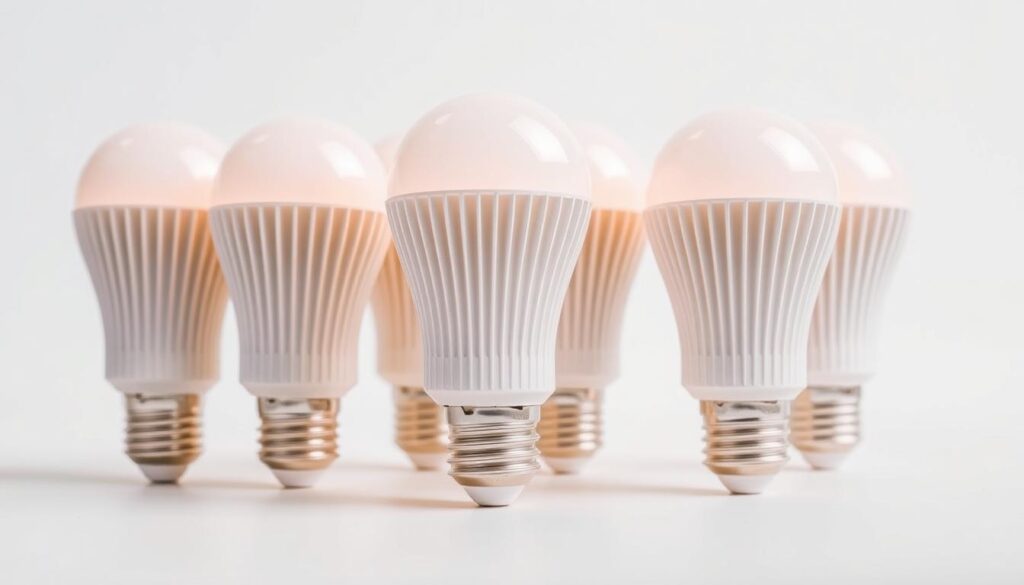
Changing all your bulbs costs $60-90 but saves $75-150 a year. LEDs last 15-25 times longer than old bulbs. This means less waste and fewer replacements.
For the best results, pick LEDs with the ENERGY STAR label. Choose the right color for each room:
- 2700K (warm white): Ideal for bedrooms and living rooms
- 3000-3500K (bright white): Perfect for kitchens and bathrooms
- 5000K (daylight): Best for home offices and reading areas
DIY Draft Stopper Installation
Drafty doors and windows can raise your heating costs by 10-15% in winter. Making simple draft stoppers is a cheap way to keep your home warm. You don’t need special skills.
You’ll need fabric, polyester fiberfill, a sewing kit, and tape for $15-25. It takes 1-2 hours to make, and it’s easy.
Here’s how to make a door draft stopper:
- Measure your door’s width
- Cut fabric to length plus 1 inch, with a width of about 8 inches
- Fold fabric in half lengthwise with right sides together and sew along the long edge
- Sew one end closed, turn right side out, then fill with rice or fiberfill
- Sew the remaining end closed and position against the door’s bottom gap
For windows, use weatherstripping tape to block drafts. This is easy to do and doesn’t damage your windows.
Smart Power Strip Implementation for Sustainable lifestyle Savings
Many devices use power even when turned off. This is called phantom energy. It can waste up to 10% of your home’s electricity.
Smart power strips stop this waste by cutting power to devices when not in use. For example, turning off your TV also cuts power to your console and speakers.
These devices cost $20-40 but save $50-100 a year. They’re easy to install. Just plug your devices into the right outlets:
- Control outlet: For the primary device (TV, computer)
- Switched outlets: For peripherals that should power down with the main device
- Always-on outlets: For devices that need constant power (routers, DVRs)
Place smart power strips in areas with many electronics. This boosts your home’s energy efficiency.
Window Insulation Film Application
Windows can lose up to 30% of your heating and cooling energy. While new windows are expensive, insulation film is a cheaper fix. It can cut heat loss by up to 40% in winter.
Window insulation kits cost $15-30 and cover many windows. Applying it takes 30 minutes per window. Here’s how to do it right:
- Clean window surfaces thoroughly with glass cleaner
- Measure and cut the film to size, allowing an extra 1-2 inches on all sides
- Apply the included double-sided tape around the window frame
- Carefully attach the film to the tape, starting at the top
- Use a hairdryer to shrink the film until it’s smooth and transparent
This solution works well for older windows. The film is easy to remove in spring without damaging your windows. It’s perfect for seasonal energy-saving improvements.
By doing these four quick projects, you’ll make your home more comfortable and save money. Each project shows results in just a month. This proves that saving energy doesn’t have to be expensive.
Water Conservation Essentials
Reducing your household water use is easy and saves money. It’s a great start for those wanting to live more sustainably. Most projects pay off in months by lowering your bills. Sustainable Home Magazine says you can cut your daily water use by 30% with simple changes.
These projects save money and help the environment. They address water scarcity concerns. With a little effort, you can make big changes without losing comfort.
Low-Flow Showerhead Installation
Standard showerheads use 2.5 gallons per minute. Low-flow ones use 1.5 gallons or less, saving 40%. For $15-45, you get a water-saving showerhead that still feels great.
It’s easy to install:
- Unscrew your old showerhead (use a wrench with cloth if stuck)
- Clean the threads and apply plumber’s tape
- Hand-tighten the new showerhead
- Check for leaks and adjust if needed
This change can save your family about 2,700 gallons a year. Look for WaterSense labels to ensure quality.
Toilet Water Displacement Methods
Toilets use a lot of water, so they’re great to save. Water displacement devices cut water use without needing a new toilet.
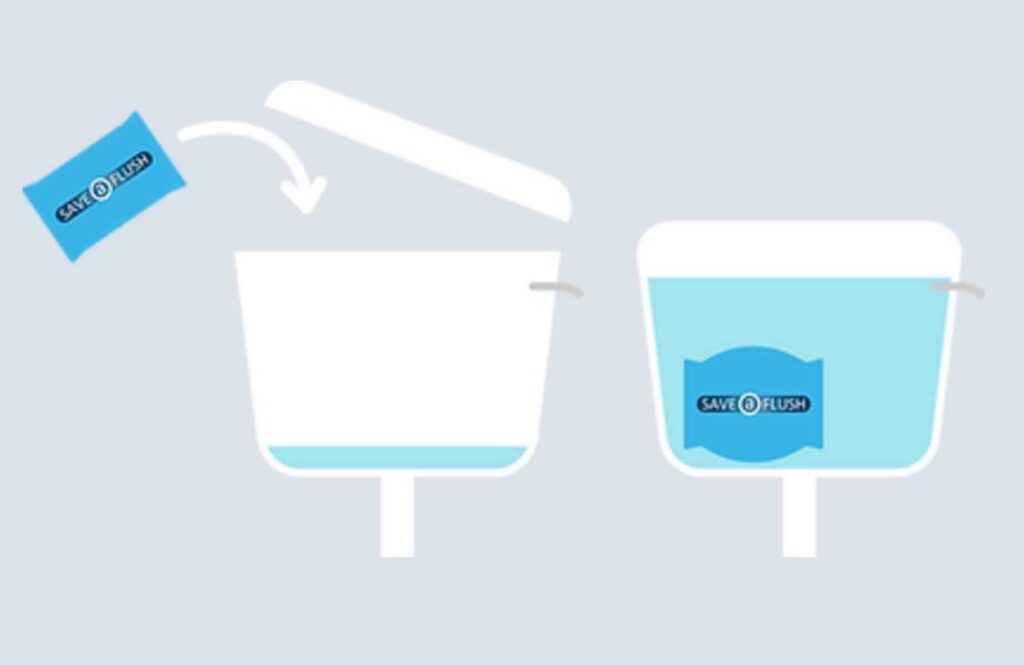
Commercial options ($5-15) include devices that install in minutes. Or, use a plastic bottle in your tank for free. Each bottle saves a gallon of water with each flush.
These methods save 0.5-1.5 gallons per flush. For a family of four, that’s 2,000-6,000 gallons saved each year. It’s a big help for the planet with little upkeep.
Faucet Aerator Upgrades
Faucet aerators are very affordable, costing $3-10 each. They attach to your faucet and mix air with water, saving water without losing pressure.
Standard faucets use 2.2 gallons per minute. Aerators can cut this to 1.5 gallons or less, saving 30%. It’s easy to install:
- Remove the old aerator from your faucet
- Clean the threads
- Screw on the new aerator (hand-tightening is enough)
It takes less than 5 minutes per faucet. Start with bathroom faucets, as they’re used most for hand washing.
Rain Barrel Collection System
Collecting rainwater is a big water-saving opportunity, saving up to 70% of water used for gardens in summer. A basic system costs $50-90, but you can make one for $25.
The idea is simple: catch rainwater from your roof in a barrel. You’ll need:
- A debris screen to keep out leaves
- A spigot for attaching a hose
- An overflow to direct excess water away
- A secure lid to keep out mosquitoes and ensure safety
Just one inch of rain on a 1,000-square-foot roof can give you over 600 gallons of water. Even a small barrel fills up quickly, giving you free water for your garden.
Check local rules before setting up your barrel. Some places offer rebates or have special rules. Sustainable Home Magazine suggests using cinder blocks to elevate your barrel for better water pressure.
These tips are easy ways to start saving water. With a little effort, you can cut your water use and help the planet while saving money.
Kitchen Waste Reduction
The kitchen is the biggest source of household waste. Making a few simple changes can help reduce waste and make your home greener. These changes cost under $100 and offer big benefits.
Countertop Compost System Setup
Food scraps make up nearly 30% of what we throw away. A countertop composting system can turn this waste into garden nutrients. There are many affordable options that fit any kitchen.
A bokashi system ($20-40) uses microbes to break down food waste, including meat and dairy. It’s sealed to prevent odors and pests, great for apartments.
Vermicomposting ($30-80) uses worms to make nutrient-rich compost. These systems work fast and produce high-quality compost. A well-maintained worm bin is odorless and can handle 3-5 pounds of waste weekly.
For a simple solution, use sealed countertop collectors ($20-30). They store scraps until you can transfer them to a compost pile or collection program. These containers often have filters to remove odors.
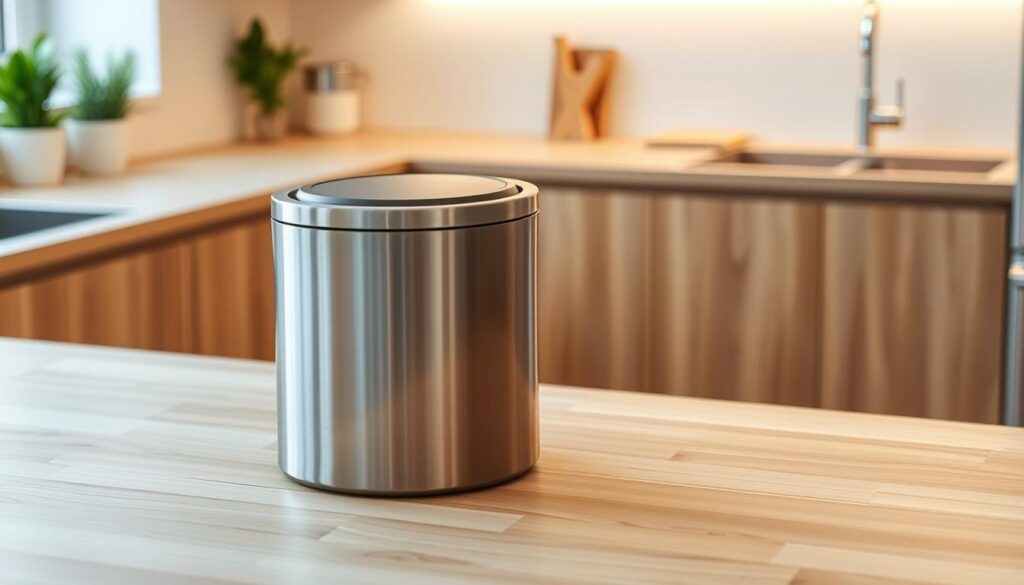
Reusable Food Storage Solutions
Single-use plastic wrap and aluminum foil waste money and harm the environment. Sustainable alternatives save money and keep food fresh longer.
Beeswax wraps ($15-25 for a set) fit containers or wrap food. They’re breathable, washable, and last 6-12 months. For a vegan option, plant-based wax wraps work the same.
Silicone food covers ($10-20) stretch to fit various sizes and seal airtight. Unlike plastic wrap, they’re reusable for years and dishwasher-safe. A set can replace hundreds of feet of plastic wrap annually.
Fabric bowl covers ($5-15) are a charming, low-tech solution. Made from cotton with elastic edges, they’re great for short-term storage. They’re machine washable and last years with care.
Sustainable Food Storage Containers
Plastic containers can leach chemicals into food and end up in landfills. Sustainable alternatives support health and the environment.
Glass containers ($30-50 for a starter set) are durable and versatile. They’re oven-safe, won’t absorb odors or stains, and let you see contents. While more expensive than plastic, their long life makes them more economical.
Stainless steel containers ($35-75 for a set) are almost indestructible and perfect for lunches and transport. They’re lightweight, won’t break, and are naturally antibacterial. Look for options with silicone seals for leak-proof storage.
For smaller items and snacks, silicone storage bags ($15-30 for 4-6) are a flexible, ziplock-style alternative. They’re dishwasher safe and reusable for years. They’re great for freezer storage and sous vide cooking.
Homemade Natural Cleaning Products
Commercial cleaners often have harsh chemicals and come in single-use plastic bottles. Making your own cleaners reduces packaging waste and makes your home healthier.
An all-purpose cleaner made from water, white vinegar, and essential oil costs less than $5. It cleans nearly every surface. One gallon of vinegar ($3-4) can replace 8-10 commercial spray bottles, saving $30-40.
For tough jobs, a paste of baking soda and water cuts through grease and grime without scratching surfaces. A 5-pound bag of baking soda ($5-7) provides enough cleaning power for 6-8 months.
Citrus-infused vinegar is a great degreaser and disinfectant. Soak citrus peels in vinegar for two weeks, strain, and dilute with water. This zero-waste solution repurposes food scraps and creates a powerful cleaner.
Store your homemade cleaners in glass spray bottles ($15-25 for a set of 3-4) to eliminate plastic waste. Label each bottle clearly and keep a small recipe card handy for easy refills. With an initial investment of $25-40 for supplies, you can replace 80-90% of conventional cleaning products at about one-third the cost.
These kitchen projects show how conscious consumption and minimalism can make a big environmental impact without losing convenience. By starting with one or two of these solutions, you’re on your way to a more sustainable, zero-waste living lifestyle that’s good for your wallet and the planet.
Home Energy Monitoring
Tracking your home’s energy use is key to a greener, cheaper living space. By watching where and how you use power, you can make smart changes. These changes cut down your carbon footprint and monthly bills. You don’t need to spend a lot to start seeing improvements. These cheap eco-friendly solutions can turn your home into a model of energy-efficient housing.
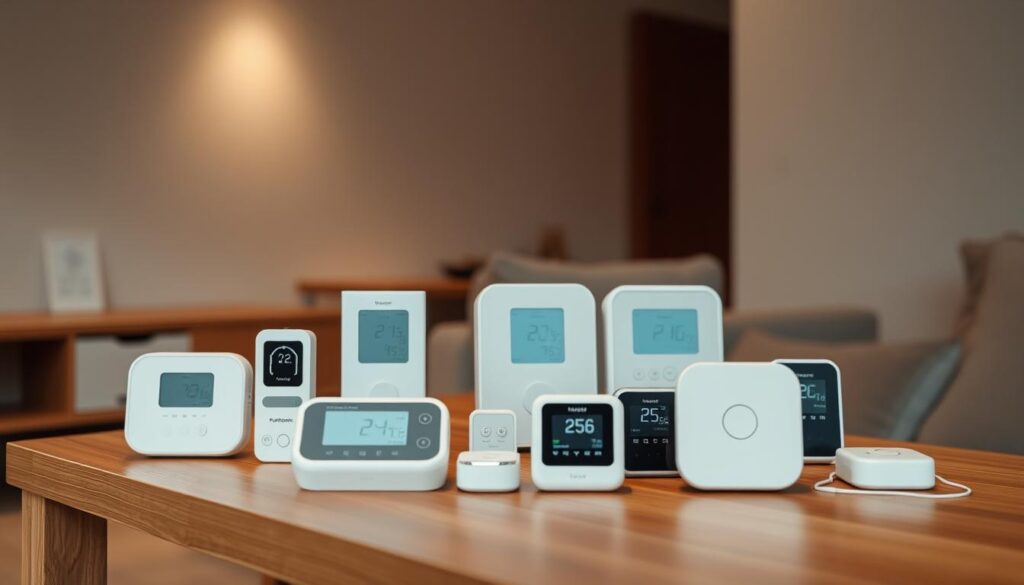
DIY Energy Audit Techniques
Before buying fancy gear, do a DIY energy audit to find problem spots. This step towards economical environmental living is cheap but gives big insights.
Start with a thermal leak detector ($25-40) to find where heated or cooled air escapes. These handheld devices use infrared to spot temperature differences that show air leaks or bad insulation.
An infrared thermometer ($15-30) does the same job but costs less. Scan walls, windows, and doorframes to find cold or hot spots that mean energy waste. If the temperature varies by more than 5-10 degrees, it’s a problem area.
- Do the “wet hand test” by wetting your hand and moving it along window and door frames—you’ll feel drafts immediately (cost: free)
- Use the “smoke test” with incense or a smoke pencil near potential leak areas to see air movement (cost: under $10)
- Look for visible light around door frames, which means gaps need fixing (cost: free)
These easy steps can find issues that waste up to 30% of your home’s energy. Take photos or notes to plan your fixes.
Smartphone-Based Power Monitoring
Turn your smartphone into a tool for managing energy with apps and affordable devices. This way of affordable renewable energy lets you understand your usage better.
Devices that connect to your utility meter ($30-50) work with free apps to show your current energy use. They help you find energy-wasting appliances and change your habits for 10-20% savings.
- Sense Energy Monitor ($299, but pays for itself in 12-18 months)
- Emporia Vue ($50-150 depending on model)
- Free apps from providers like ComEd, PG&E, and Duke Energy
These systems are great for tracking your energy use and seeing how changes help. Many people save $15-30 a month by fixing energy waste.
Smart Plug Installation Guide
Smart plugs are a simple way to start monitoring your home’s energy. These affordable devices ($10-25 each) turn regular outlets into smart energy stations.
Installing them is easy:
- Plug the smart plug into any standard outlet
- Connect the device you want to monitor to the smart plug
- Download the app and pair it
- Name each plug for location or device
Once set up, smart plugs let you track energy use, control devices remotely, and set schedules. Focus on devices that use power when not in use, like entertainment centers and kitchen appliances.
Using 4-6 smart plugs can save $40-120 a year. They’re a smart choice for anyone looking to live more sustainably without spending a lot.
Window and Door Weatherstripping
Weatherstripping is a cheap way to make your home more energy-efficient. It stops air from leaking around doors and windows, which can waste up to 15% of your heating and cooling costs.
Choose the right materials for each spot:
- V-strip/tension seal ($5-10): Good for window sides and door jambs
- Foam tape ($3-8): Best for irregular cracks and window sashes
- Door sweeps ($10-20): Seal the gap at the bottom of doors
- Silicone caulk ($5-8): For non-moving parts and small gaps
Measure each area before buying materials. For doors, you’ll need 7-8 feet of weatherstripping and a door sweep. For windows, measure the whole perimeter and add 10% for waste.
This $25-75 investment can cut heating and cooling costs by 10-15%. It pays for itself in one season. Plus, your home will feel warmer and draft-free.
Check your DIY energy audit results after installing weatherstripping. You’ll see big improvements in treated areas. This makes your home more energy-efficient housing using renewable resources better.
Zero-Waste Bathroom Upgrades
The bathroom is a big source of plastic waste and water use. But, you can make changes to fix this. With some simple and affordable steps, you can make your bathroom more eco-friendly. This will save you money and help the planet.
Changing your bathroom can cost less than $100. You can get rid of single-use plastics, save water, and use natural products. These changes will make your bathroom better and more eco-friendly.
Package-Free Toiletry Alternatives
Switching to solid toiletries cuts down on plastic waste. Solid shampoo and conditioner bars last longer than bottled ones. They clean well without the extra plastic or water.
Using refillable dispensers for hand soap and lotion is stylish and saves packaging. You can refill them at natural grocery stores for less money.
Safety razors are a smart choice for saving money and waste. They cost more upfront but save you money in the long run. They also give a closer shave and are better for your skin.
Bamboo toothbrushes are a simple way to reduce waste. They’re cheap and work well with tablet toothpaste or powder. This makes your oral care routine plastic-free.
Water-Saving Toilet Modifications
Toilets use a lot of water, but you can save it. A dual-flush converter kit lets you use less water. It’s easy to install and saves a lot of water.
Installing a dual-flush converter is quick:
- Turn off the water supply to your toilet
- Remove the tank lid and flush the toilet
- Disconnect the flapper chain
- Install the new dual-flush mechanism according to package instructions
- Adjust water levels as needed
Adjusting your toilet’s fill valve also saves water. It’s a simple fix that costs nothing. Just adjust the float to stop water flow about one inch below the overflow tube.
A displacement device in your tank also saves water. You can use a sealed water bottle or pebbles. This is a cheap way to save a lot of water every day.
DIY Natural Bath Products
Making your own bath products saves packaging and chemicals. With basic ingredients, you can make many products for less money. This is a smart way to save money and be eco-friendly.
Homemade bath bombs are easy and cheap to make. They cost less than commercial ones and are better for the environment. You can make 6-8 bath bombs with just a few ingredients.
- 1 cup baking soda
- 1/2 cup citric acid
- 1/2 cup Epsom salt
- 1/2 cup cornstarch
- 2 tablespoons oil (almond, coconut, or olive)
- 10-15 drops essential oil
Natural sugar scrubs are a great alternative to commercial ones. They’re cheap and effective. You can make a spa-quality scrub for about $2.
Making your own cleaning spray is cheap and eco-friendly. It uses vinegar, water, and essential oils. This saves money and reduces waste.
Upcycled Bathroom Storage Solutions
Using old items for storage is smart and stylish. Mason jars are great for storing small items. A coat of paint makes them look new.
Wine crates make great open shelving for towels and toiletries. They’re free if you get them from wine shops. A little sanding and paint can make them look designer.
An old ladder is perfect for towel storage. It adds character and keeps towels easy to reach. This is a free project that’s both useful and stylish.
Using glass food jars for storage is a smart idea. They look good and save you money. This shows how you can be eco-friendly and stylish at the same time.
“The most sustainable product is the one you already own, repurposed with creativity and intention.”
By making these changes, you’ll help the environment and make your bathroom better. These upgrades show that you can live sustainably without giving up anything. In fact, many eco-friendly options are better and save money too.
Small Space Apartment Solutions
Living in an apartment doesn’t mean you have to give up on being green. With a little creativity, even the smallest spaces can have a big impact on the environment.
Portable Energy-Saving Devices
Change how you use energy with easy-to-use solutions that won’t bother your landlord. Portable solar chargers ($25-60) use sunlight to charge your devices. USB-powered LED lights ($15-40) use up to 80% less electricity than regular bulbs.
Renter-Friendly Window Treatments
Make your apartment more efficient without worrying about losing your deposit. Removable window films ($10-25) and tension rod curtains ($20-50) improve insulation by 20-40%. They’re easy to install and can save you money on heating and cooling.
Vertical Herb Garden Installation
Start your own urban garden by growing plants up instead of out. Wall-mounted planters and hanging containers ($40-90) let you grow herbs all year in a small area. This system cuts down on packaging waste and gives you fresh herbs right in your kitchen.
Compact Composting Methods
Don’t throw away kitchen scraps. Bokashi systems and countertop worm bins ($20-60) turn food waste into fertilizer without any smell. If you can’t compost at home, many cities have community gardens with shared composting facilities nearby.
Sustainable living is about both personal and community efforts. Join local tool libraries, seed exchanges, and garden shares. This way, you can make a bigger difference while keeping costs low.

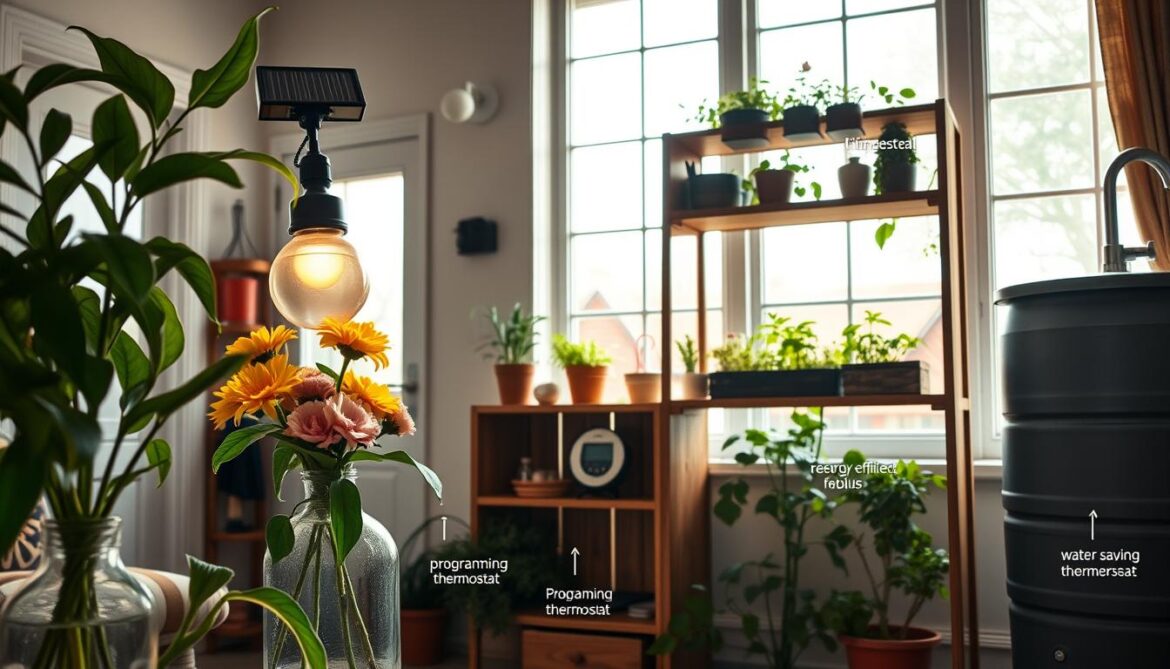

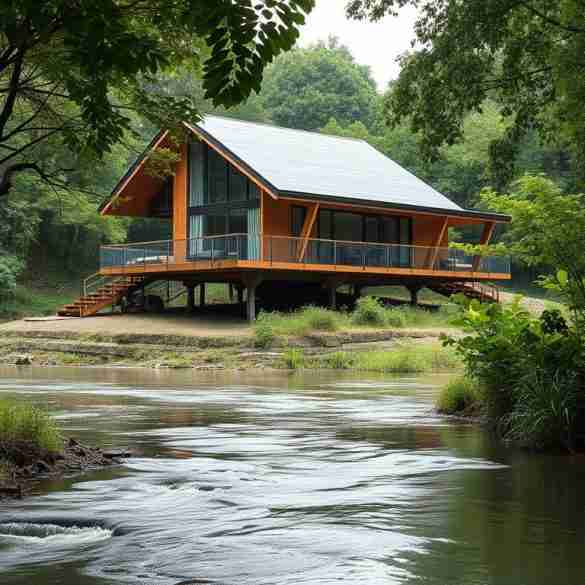


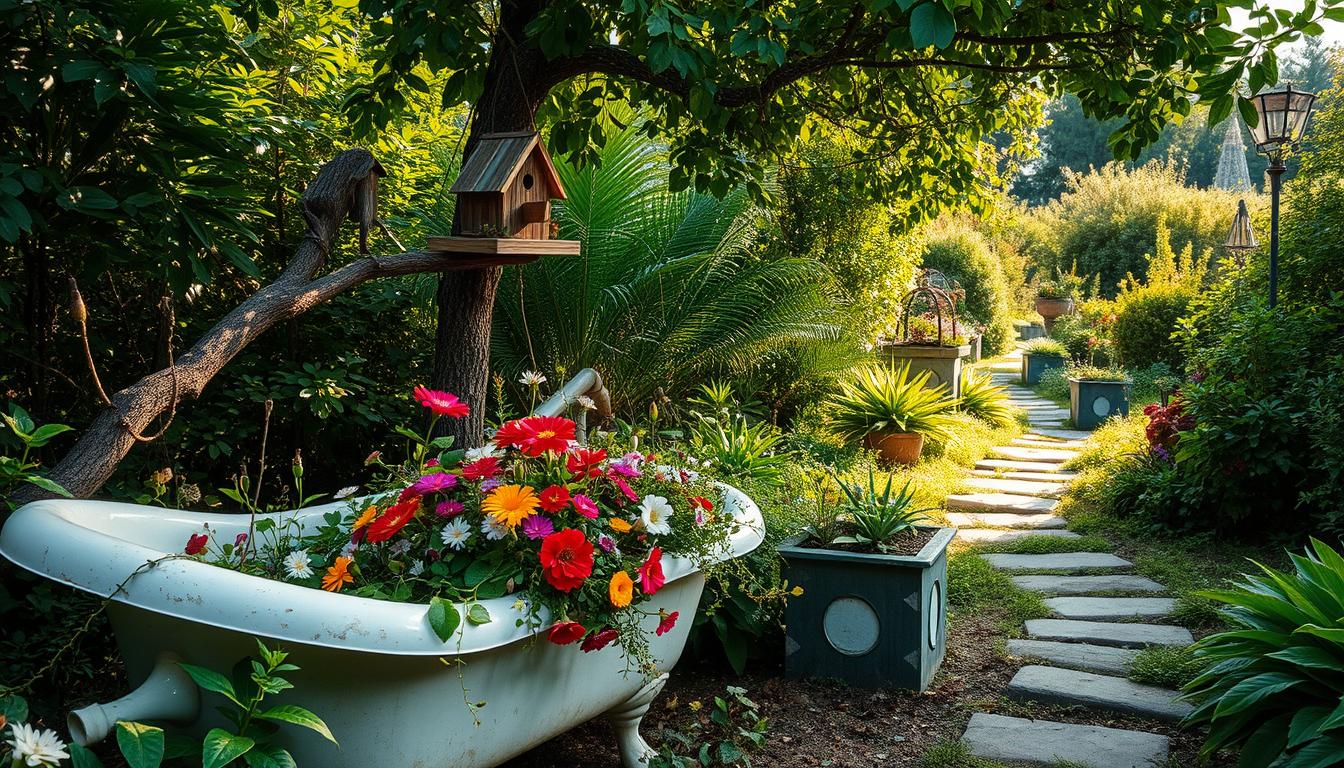

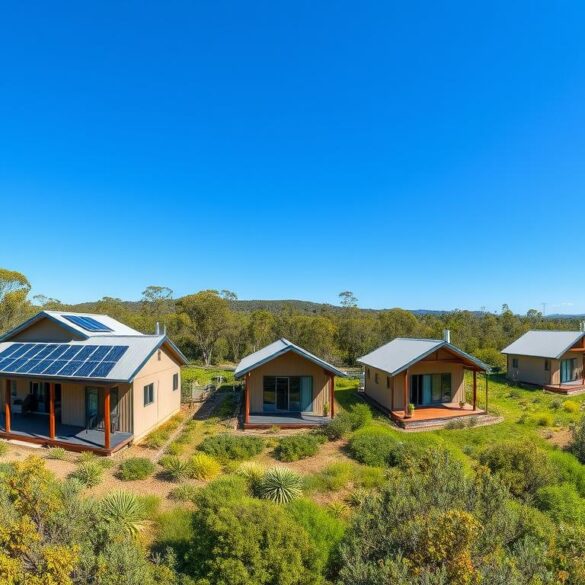

1 comment
[…] solar projects are a great way to live sustainably and save money. They’re perfect for powering small homes or adding green energy to your house. Knowing […]